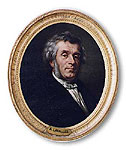
Alphonse Lavallée
Encyclopedia

École Centrale Paris
École Centrale Paris is a French university-level institution in the field of engineering. It is also known by its original name École centrale des arts et manufactures, or ECP. Founded in 1829, it is one of the oldest and most prestigious engineering schools in France and has the special status...
, a French Grande École.
He was born in 1791 in Savigné-l'Évêque (Sarthe
Sarthe
Sarthe is a French department, named after the Sarthe River.- History :The department was created during the French Revolution on March 4, 1790, pursuant to the law of December 22, 1789, starting from a part of the province of Maine which was divided into two departments, Sarthe to the east and...
region, France
France
The French Republic , The French Republic , The French Republic , (commonly known as France , is a unitary semi-presidential republic in Western Europe with several overseas territories and islands located on other continents and in the Indian, Pacific, and Atlantic oceans. Metropolitan France...
). He became a businessman in the region of Nantes
Nantes
Nantes is a city in western France, located on the Loire River, from the Atlantic coast. The city is the 6th largest in France, while its metropolitan area ranks 8th with over 800,000 inhabitants....
. At the end of the 1820s he decided to create a new school of engineering for the emerging industrial sector, at a time where all the leading institutions were essentially training engineers for public administration. He founded in 1829 the École centrale des arts et manufactures, now also known as the École Centrale Paris
École Centrale Paris
École Centrale Paris is a French university-level institution in the field of engineering. It is also known by its original name École centrale des arts et manufactures, or ECP. Founded in 1829, it is one of the oldest and most prestigious engineering schools in France and has the special status...
, with the help of three scientists : the chemist Jean-Baptiste Dumas
Jean-Baptiste Dumas
Jean Baptiste André Dumas was a French chemist, best known for his works on organic analysis and synthesis, as well as the determination of atomic weights and molecular weights by measuring vapor densities...
, the physicist Jean Claude Eugène Péclet
Jean Claude Eugène Péclet
Jean Claude Eugène Péclet was a French physicist.He was born in Besançon, France.Péclet became, in 1812, one of the first students of the École Normale in Paris with Gay-Lussac and Dulong being his professors. In 1816, he was elected professor at the Collège de Marseille and taught physical...
and the mathematician Théodore Olivier. He gave the money for establishing the school in Paris
Paris
Paris is the capital and largest city in France, situated on the river Seine, in northern France, at the heart of the Île-de-France region...
and became the first president (directeur) of the institution. The first location was the Hôtel de Juigné in the Marais
Le Marais
Le Marais is a historic district in Paris, France. Long the aristocratic district of Paris, it hosts many outstanding buildings of historic and architectural importance...
(now building of the Picasso Museum).
His son developed an arboretum
Arboretum
An arboretum in a narrow sense is a collection of trees only. Related collections include a fruticetum , and a viticetum, a collection of vines. More commonly, today, an arboretum is a botanical garden containing living collections of woody plants intended at least partly for scientific study...
in the park of the Château de Segrez in Saint-Sulpice-de-Favières (Essonne
Essonne
Essonne is a French department in the region of Île-de-France. It is named after the Essonne River.It was formed on 1 January 1968 when Seine-et-Oise was split into smaller departments.- History :...
), which was one of the biggest in Europe
Europe
Europe is, by convention, one of the world's seven continents. Comprising the westernmost peninsula of Eurasia, Europe is generally 'divided' from Asia to its east by the watershed divides of the Ural and Caucasus Mountains, the Ural River, the Caspian and Black Seas, and the waterways connecting...
at this time.
He died in Paris in 1873 and is buried in the Père Lachaise Cemetery
Père Lachaise Cemetery
Père Lachaise Cemetery is the largest cemetery in the city of Paris, France , though there are larger cemeteries in the city's suburbs.Père Lachaise is in the 20th arrondissement, and is reputed to be the world's most-visited cemetery, attracting hundreds of thousands of visitors annually to the...
.

